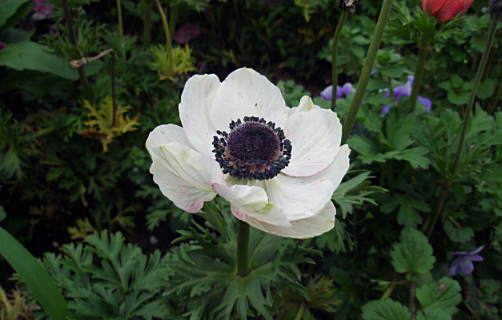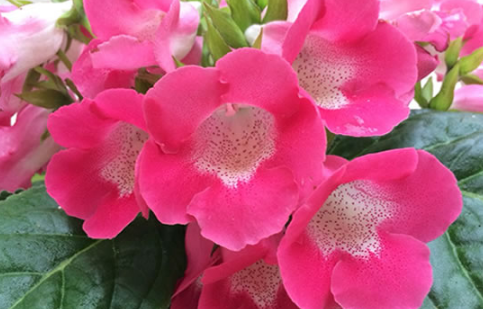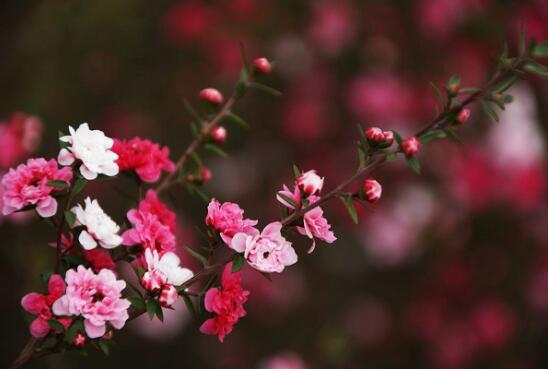Culture skills of anemone
Planting
Before planting anemone, the root should be soaked in water for 1-2 days, so that the anemone seed can absorb water and expand. 3 parts of garden soil, 1 part of rotten leaf soil and 1 part of rice chaff ash are used in basin soil. 1 handful of rotten compost or chicken manure is used in each pot. 3-5 balls can be planted in a basin with a diameter of 20 cm. When planting, the tip of the root should be downward, not inverted. After planting, pour water thoroughly, put in the sunny place, about 20 days can grow new leaves.

Fertilizer and water
Due to the low temperature in winter, anemone water consumption is small, watering should be controlled not to make the pot soil too damp, to prevent root rot, depending on the humidity, generally about 3 days to irrigate once, if the temperature is low, less watering, fertilizer once every half a month 10% cake fertilizer.
Fertilization at flowering stage
During the anemone flowering, applying 10% cake fertilizer and water once a week can promote the continuous formation of flower buds until the temperature rises in May. From March to April, if there is harm to leaf miners, 1500 times omethoate can be sprayed and sprayed again every 3-5 days.
Post-anthesis maintenance
After the anemone blossoms, the temperature rises, and the old leaves begin to turn yellow. when the leaves almost wither in June, you can dig up the underground roots, but do not divide them immediately, pay attention to prevent water, and store them in a dry and ventilated place with bamboo baskets and other things. Potted plants can be put in a dry shelter, stop watering, and turn the pot again in September.
Overwintering maintenance
In winter, anemone can continue to grow above 5 ℃, form buds and blossom early. When anemone is cultivated in open field, the air temperature is not lower than-10 ℃, it can survive the winter safely. In the spring of next year, anemone begins to grow around mid-February. If light fertilizer is applied diligently, it can blossom in March.
The above is an introduction to the question of how to raise anemone. Let's learn what we need to pay attention to in the process of anemone cultivation.
The cultivation method of anemone anemone can be planted from early September to mid-November in southern China, and the flowering period is from mid-November to late April. Cultivation in the greenhouse requires certain facilities such as heat preservation, drip irrigation, shading, ventilation and so on. Anemone planting under natural conditions is usually carried out in late September when the temperature is below 20 degrees. Before planting, soak the tuber root with water for 1-2 days to make it absorb water and expand. 3 parts of garden soil, 1 part of rotten leaf soil and 1 part of rice chaff ash are used in basin soil. 1 handful of rotten compost or chicken manure is used in each pot. 3-5 balls can be planted in a basin with a diameter of 20 cm. When planting, the tip of the root should be downward, not inverted. After planting, pour water thoroughly, put in the sunny place, about 20 days can grow new leaves. Keep more than 5 degrees in the greenhouse or greenhouse in winter to continue to grow, form buds and blossom early, but at this time, due to low temperature and low water consumption, watering should be controlled not to make the pot soil too damp, to prevent root rot, depending on the humidity, generally about 3 days to irrigate, if the temperature is low, less watering, fertilizer once every half month 10% cake fertilizer. When cultivated in open field, the temperature is not lower than-10 degrees can survive the winter safely, spring begins next year, and begins to grow around mid-February. If it can be applied lightly, it can blossom in March. During flowering, applying 10% cake fertilizer and water once a week can promote the continuous formation of flower buds until the temperature rises in May. From March to April, if there is harm to leaf miners, 1500 times omethoate can be sprayed and sprayed again every 3-5 days. When the temperature rises after anthesis, the old leaves begin to turn yellow. when the leaves almost wither in June, you can dig up the underground roots, but do not divide them immediately, pay attention to prevent water, and store them in a dry and ventilated place with bamboo baskets and other things after being fully cool and dried. Potted plants can be put in a dry shelter, stop watering, and turn the pot again in September. The single flowering period of European anemone is about a week, and the seeds mature 7-10 days after flowering, when the aggregate fruit changes from turquoise to grayish yellow, and the fruit feels soft, that is, it should be harvested in time, otherwise it is easy to be scattered with the wind. The seeds should be dried after harvest and stored in a safe and ventilated place. Culture methods and matters needing attention of anemone
Selection of potted soil for cultivation of anemone
In order to cultivate anemone, we can choose the mixed basin soil, mix the garden soil, rotten leaf soil and plant ash according to a certain proportion, and add some base fertilizer, which requires good drainage.
Light and temperature
The cultivation of anemone needs to meet the two conditions of cool and sufficient light. Anemone can be cold-resistant, but avoid high temperature, the suitable temperature for growth is between 15 ℃-35 ℃, the temperature in winter is not less than 10 ℃, it can be safely spent through the winter, it can be put in a sunny place indoors, and can be maintained in a greenhouse if possible.
Watering and fertilizing
Culture anemone, need to keep the soil moist, but watering should be careful, do not make the basin soil too wet, lest the roots rot. The trumpet with less moisture in winter can reduce watering, while in rainy seasons, anemones need to be kept in a dry place, pay attention to shelter from rain, and stop watering. Fertilization is generally applied every half a month thin fertilizer and water, during flowering, in order to promote the formation of flower buds, can be applied once a week.
Reproduction method
The reproduction of anemone is mainly sowing and dividing balls, sowing is autumn sowing, and seeds are sown as they are picked. Bulb reproduction is mainly about the division and planting of anemone bulbs.
Matters needing attention in Anemone Culture Diseases and insect pests
Anemone will have diseases and insect pests, diseases are mainly rot, blight, gray mold, powdery mildew and so on, the harm is more serious, need timely control, pests are mainly aphids and ground tigers, you can use commonly used pesticides to kill.
Seed collection
Anemone can be sown, and the seeds are usually sown as they are picked. The seeds must be harvested in time, otherwise they will be blown down by the wind, and the harvested seeds should be kept in a ventilated and dry place for maintenance.
- Prev

What about the yellowing of paulownia leaves?
1. The reason for too much watering: paulownia prefers to be wet, but it can't be watered more. Too much watering will make the leaves yellow and rotten. Solution: big paulownia should be watered less, do not dry, do not water, winter plants enter the dormant period, can stop watering. And can not be watered on the leaves, there are more fluff on the leaves, watering will appear water stains
- Next

Culture method of Songhongmei
1. Ample sunshine the sunny environment that pine and red plum like, and the fear of cold places, so we should give Songhongmei plenty of sunshine. However, we should pay attention to the sunshade treatment of Songhongmei in the hot summer. 2. timely fertilization of Songhongmei although the requirements for the soil are not strict, but in the fertile and loose
Related
- Fuxing push coffee new agricultural production and marketing class: lack of small-scale processing plants
- Jujube rice field leisure farm deep ploughing Yilan for five years to create a space for organic food and play
- Nongyu Farm-A trial of organic papaya for brave women with advanced technology
- Four points for attention in the prevention and control of diseases and insect pests of edible fungi
- How to add nutrient solution to Edible Fungi
- Is there any good way to control edible fungus mites?
- Open Inoculation Technology of Edible Fungi
- Is there any clever way to use fertilizer for edible fungus in winter?
- What agents are used to kill the pathogens of edible fungi in the mushroom shed?
- Rapid drying of Edible Fungi

